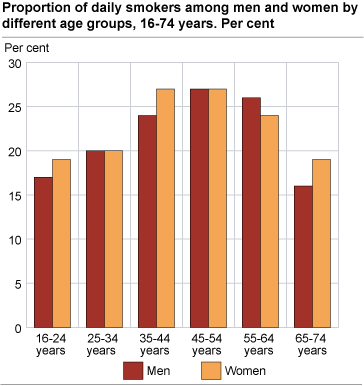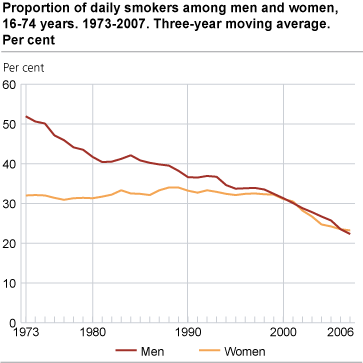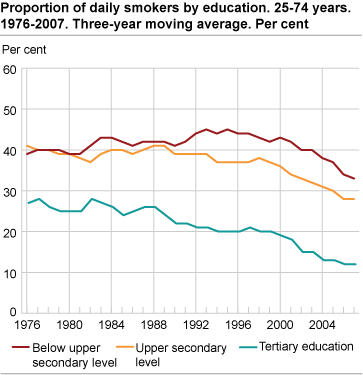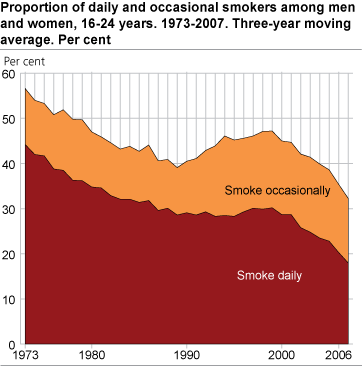Content
Published:
This is an archived release.
Daily smoking is becoming less common
22 per cent of all 16-74 year-olds smoked on a daily basis in 2007, a decrease of 2 percentage points compared with 2006. Smoking prevalence has fallen steadily in Norway since 1998, and young people are leading the way.
Statistics Norway conducts surveys on smoking prevalence every year. The 2007 surveys show that 22 per cent of the population aged 16-74 smoke on a daily basis, compared with 24 per cent in 2006. In addition, approximately 10 per cent smoked occasionally in 2007, unchanged from 2006.
There are some differences between men and women with regards to smoking. The proportion of daily smokers is 23 per cent for women and 21 per cent for men. The corresponding figures in 2006 were 24 per cent in both groups.
The largest proportion of daily smokers is found in the age group 35-64 years, while the smallest proportion is reported by the youngest and the oldest age groups.
Decrease since 1998
In 1973, more than half of the adult male population smoked, compared with 24 per cent today. From 1973 to 2000, the proportion of women who smoke every day was slightly higher than 30 per cent, but this figure has also fallen considerably and is now 23 per cent. There seems to have been a shift in smoking prevalence around 1998. Since then, smoking has gone down for both men and women.
Fewer smokers among young people
In 2007, about 16 per cent of young people aged 16-24 said that they smoke on a daily basis, a decrease from 20 per cent in 2006, although the difference is not significant2. The sample is relatively small and is therefore best suited to study long-term trends rather than annual changes.
The number of young people who start smoking has fallen considerably since the 1970s. The major decline in smoking prevalence observed from the 1970s to the end of the 1980s was followed by a marked increase in the first half of the 1990s. However, the development now seems to be moving in a positive direction, and the number of young people who smoke is falling markedly.
Education matters
Education has a substantial effect on smoking prevalence. Smoking is three times more common among people with lower secondary education than among people with tertiary education. The number of daily smokers among people with tertiary education has fallen considerably since the mid 1970s, while this trend only started around 2000 for people with less education. When seen in relation to the total share of smokers, the change in the level of education in the population as a whole must be taken into account (see http://www.ssb.no/english/subjects/04/01/ ).
About the survey
Statistics Norway has conducted surveys on smoking prevalence since 1973. The proportion of smokers is measured by two questions: "Do you sometimes smoke?" and "Do you smoke daily or occasionally?" In the course of a year, four surveys with a total net sample of 5 000 people are carried out.
| Year | Daily smokers 16-74 years | Daily smokers 16-24 years | |||||||||||||||||||||||||||||||||||||
|---|---|---|---|---|---|---|---|---|---|---|---|---|---|---|---|---|---|---|---|---|---|---|---|---|---|---|---|---|---|---|---|---|---|---|---|---|---|---|---|
| Observed result |
Estimated three
year sliding average |
Sample size (N) | Observed result |
Estimated three
year sliding average |
Sample size (N) | ||||||||||||||||||||||||||||||||||
| 1997 | 33.6 | 33.2 | 5 305 | 30.6 | 30.1 | 819 | |||||||||||||||||||||||||||||||||
| 1998 | 33.0 | 32.9 | 5 088 | 31.2 | 29.9 | 797 | |||||||||||||||||||||||||||||||||
| 1999 | 32.0 | 32.3 | 4 913 | 27.7 | 30.2 | 783 | |||||||||||||||||||||||||||||||||
| 2000 | 31.9 | 31.2 | 5 004 | 31.5 | 28.7 | 806 | |||||||||||||||||||||||||||||||||
| 2001 | 29.8 | 30.3 | 5 047 | 26.8 | 28.7 | 781 | |||||||||||||||||||||||||||||||||
| 2002 | 29.4 | 28.5 | 5 311 | 27.8 | 25.8 | 819 | |||||||||||||||||||||||||||||||||
| 2003 | 26.3 | 27.3 | 5 094 | 22.8 | 24.8 | 812 | |||||||||||||||||||||||||||||||||
| 2004 | 26.0 | 25.8 | 5 034 | 23.7 | 23.5 | 852 | |||||||||||||||||||||||||||||||||
| 2005 | 25.0 | 25.0 | 5 029 | 24.1 | 22.8 | 833 | |||||||||||||||||||||||||||||||||
| 2006 | 23.9 | 23.6 | 4 756 | 20.3 | 20.3 | 763 | |||||||||||||||||||||||||||||||||
| 2007 | 21.7 | 22,8* | 4 813 | 15.5 | 118.0 | 682 | |||||||||||||||||||||||||||||||||
| 1 | Average of 2006 and 2007. |
|
There are possible sources of error in any interview survey. Therefore, error margins of more than one percentage point both ways are used. To reduce the effect of random changes in the data, a three-year moving average is used. This is particularly important in periods where the sample has been smaller than it is today. A three-year moving average means that the average of the results for three consecutive years is calculated, and that this average represents the second year. |
The statistics are compiled on behalf of the Directorate for Health and Social Affairs.
2 With a 95 per cent confidence interval
Contact
-
Elin Skretting Lunde
E-mail: elin.skretting.lunde@ssb.no
tel.: (+47) 92 42 70 07
-
Jorun Ramm
E-mail: jorun.ramm@ssb.no
tel.: (+47) 92 08 23 99
-
Arne Jensen
E-mail: arne.jensen@ssb.no
tel.: (+47) 99 71 22 45




